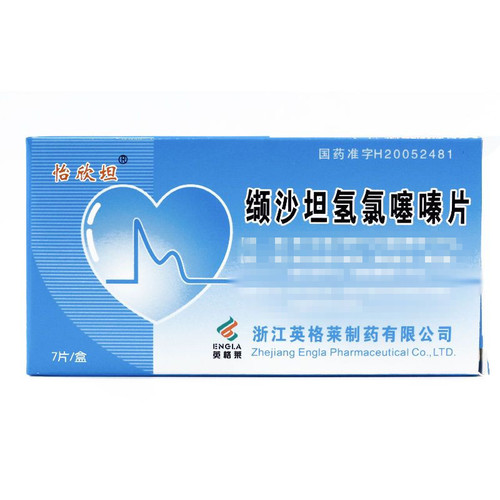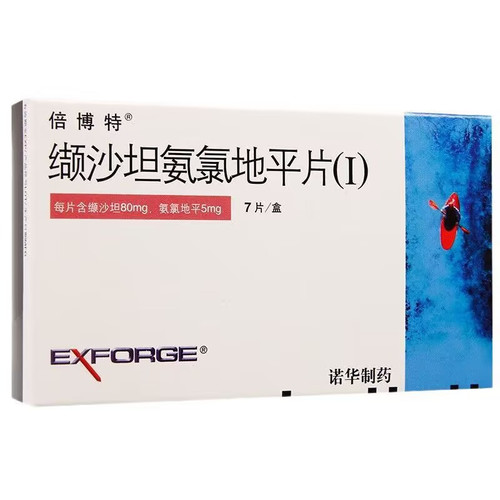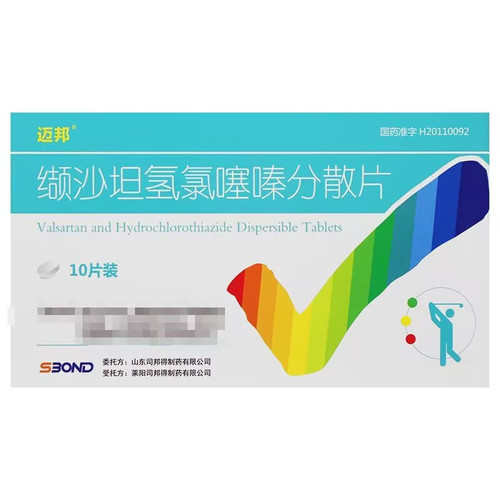Product Overview
[Drug Name]
Generic Name: Valsartan and Hydrochlorothiazide Tablets
Trade Name: Fu Dai Wen
English Name: Valsartan and Hydrochlorothiazide Tablets
Chinese Pinyin: Xie Sha Tan Qing Lv Sai Qin Pian (Fu Dai Wen)
[Ingredients]
This product is a combination preparation. Each tablet contains 80 mg of valsartan and 12.5 mg of hydrochlorothiazide.
[Properties]
This product is a film-coated tablet that appears white or off-white after removal of the coating.
[Indications]
It is used to treat mild to moderate essential hypertension in patients whose blood pressure cannot be adequately controlled with a single medication. This product is not suitable for the initial treatment of hypertension.
[Dosage and Administration]
The recommended dose of valsartan monotherapy is 80 mg once daily. If the antihypertensive effect is unsatisfactory, the daily dose can be increased to 160 mg. The effective dose of hydrochlorothiazide is 12.5 to 50 mg once daily. To reduce dose-independent adverse reactions, combination therapy is generally considered only when monotherapy fails to achieve satisfactory results. Adverse reactions of valsartan are generally rare and independent of dose. The primary adverse reaction of hydrochlorothiazide is hypokalemia, which is dose-related. The primary dose-independent adverse reaction is pancreatitis. When valsartan and hydrochlorothiazide are used together, the dose of each drug may need to be adjusted. Once the dose adjustment is satisfactory, this product can be substituted for the combination drug at the same dose. Dose adjustment: Each tablet of this product contains 80 mg of valsartan and 12.5 mg of hydrochlorothiazide. If blood pressure is not adequately controlled with valsartan monotherapy or with 25 mg of hydrochlorothiazide once daily, or if hypokalemia occurs, this product (containing 80 mg of valsartan and 12.5 mg of hydrochlorothiazide) can be used as an alternative, once daily. Maximum antihypertensive effect is achieved within 2-4 weeks of treatment. This product can be taken regardless of mealtime. No dose adjustment is required for patients with mild to moderate renal failure (creatinine clearance ≥30 m/min) or mild to moderate hepatic failure.
[Adverse Reactions]
In two controlled clinical trials involving a total of 1,570 patients, 730 of whom received valsartan in combination with hydrochlorothiazide, the following adverse events were reported: Central Nervous System Common (>5%): Headache (10.8% vs. 17.2% for placebo) and dizziness. Uncommon (5-0.1%): Erectile dysfunction and depression. Upper Respiratory Tract Uncommon (5-0.1%): Cough, rhinitis, sinusitis, pharyngitis, upper respiratory tract infection, and epistaxis. Gastrointestinal Uncommon (5-0.1%): Nausea, diarrhea, dyspepsia, and abdominal pain. Lower Urinary Tract Uncommon (5-0.1%): Frequent urination and urinary tract infection. Musculoskeletal system: Uncommon (5-0.1%): Arm or leg pain, arthritis, myalgia, sprains and strains, and muscle spasms. Other uncommon (5-0.1%): Asthenia, chest pain, weakness, viral infection, visual disturbances, and conjunctivitis. Rare reports of angioedema, pruritic rash, and other allergic reactions such as serum sickness and vasculitis have occurred since the product's introduction into the market. Laboratory tests revealed a decrease in serum potassium greater than 20% in 5.8% of patients treated with the same product and 3.3% of patients receiving placebo. The following adverse events are associated with valsartan alone and not with this product. Valsartan has rarely caused decreases in hemoglobin and hematocrit. In controlled clinical trials, significant decreases (>20%) in hemoglobin and hematocrit occurred in 0.8% and 0.4% of patients treated with valsartan, respectively, compared to 0.1% in the placebo group. In controlled clinical trials, the incidence of neutropenia was 1.9% in the valsartan group and 1.6% in the ACEI group. Significant increases in serum creatinine, potassium, and total bile duct were observed in 0.8%, 4.4%, and 6% of the valsartan group, respectively, and in 1.6%, 6.4%, and 12.9% of the ACEI group, respectively. Elevated liver function tests were occasionally observed. Specific laboratory monitoring is not required in patients with essential hypertension receiving valsartan. Other adverse reactions reported in valsartan clinical trials include: Uncommon (5-0.1%): arthralgia, gastroenteritis, and neuralgia. There was only one case of angioedema reported. A causal relationship with valsartan treatment has not been demonstrated. The following adverse reactions have been reported in patients receiving monotherapy with hydrochlorothiazide diuretics (including hydrochlorothiazide), most of which were at doses higher than those used in this product: electrolyte and metabolic disturbances (see [Precautions]). Common (>5%): hypokalemia. Uncommon (5-0.1%): Hyponatremia, hypomagnesemia, and hyperuricemia. Rare (<0.1%): Hypercalcemia, increased blood glucose, glycosuria, and worsening diabetes mellitus. Very rare: Hypochloremic alkalosis. Occasional (5-0.1%): Urticaria and other types of rash. Rare (<0.1%): Photosensitivity. Very rare: Necrotizing vasculitis, acute toxic epidermolysis, lupus erythematosus-like reaction, cutaneous lupus erythematosus flare. Occasional (5-0.1%): Loss of appetite, mild nausea, and vomiting. Rare (<0.1%): Abdominal symptoms, constipation, diarrhea, and gastrointestinal symptoms. Very rare: Pancreatitis. Rare (<0.1%): Intrahepatic cholestasis or jaundice. Occasional (5-0.1%): Cardiovascular system: Aggravated by orthostatic hypotension, alcohol, anesthesia, or sedatives. Rare (<0.1%): Cardiac arrhythmia. Central nervous system: Rare (<0.1%): Headache, dizziness or photo-headache, sleep disturbance, depression, paresthesia. Sensory organ visual disturbances, especially during the first few weeks of treatment. Hematologic: Rare (<0.1%): Thrombocytopenia, occasionally with purpura. Very rare: Leukopenia, granulocytopenia, bone marrow suppression, hemolytic anemia. Other rare (5-0.1%): Impotence. Very rare: Allergic reactions, including respiratory symptoms of pneumonitis and pulmonary edema.
[Contraindications]
Hypersensitivity to any of the ingredients in this product or to sulfonamide derivatives. Pregnancy (see [Use in Pregnant and Lactating Women]), severe liver failure, biliary cirrhosis, or cholestasis. Severe renal failure (creatinine clearance <30 ml/min) or anuria. Refractory hypokalemia, hyponatremia, or hypercalcemia, and symptomatic hyperuricemia (history of gout or uric acid stones).
[Precautions]
Serum electrolyte changes require caution when used with potassium-sparing diuretics, potassium supplements, potassium-containing salt substitutes, or other medications that increase serum potassium levels (e.g., heparin). Therefore, serum potassium levels should be monitored regularly. Thiazide diuretics are associated with hyponatremia and hypochloremic alkalosis. Thiazides can cause hypomagnesemia by increasing renal magnesium excretion. Sodium and/or volume depletion: In rare cases, symptomatic hypotension may occur when initiating treatment with this medication in patients with severe sodium and/or volume depletion (e.g., those taking high-dose diuretics). Hyponatremia and/or volume depletion should be corrected before initiating treatment with this medication. If hypotension occurs, the patient should be placed in the supine position and, if necessary, given normal saline. Treatment can be resumed after blood pressure stabilizes. Renal Artery Stenosis: There is no experience with this medication in patients with unilateral or bilateral renal artery stenosis or solitary kidney stenosis. For renal impairment, no dose adjustment is required for patients with a creatinine clearance ≥30 ml/min. Hepatic Impairment: This drug should be used with caution in patients with mild to moderate non-cholestatic hepatic impairment. However, since the daily dose of valsartan (80 mg) does not exceed the recommended limit and the pharmacokinetics of hydrochlorothiazide are not significantly affected by hepatic impairment, no dose adjustment is required in such patients. Systemic Lupus Erythematosus: Thiazide diuretics can cause or exacerbate systemic lupus erythematosus. Other Metabolic Disorders: Thiazide diuretics can impair glucose tolerance and increase serum cholesterol, triglyceride, and uric acid levels. Effects on Ability to Drive and Operate Machinery: As with other antihypertensive drugs, patients taking this drug should exercise caution when driving and operating machinery. Athletes should use with caution. Read the package insert carefully and use as directed by your healthcare provider.
[Use in Special Populations]
Precautions in Pediatrics:
Insufficient data exist regarding the therapeutic use of this drug in children.
Precautions During Pregnancy and Lactation:
During the second and third trimesters of pregnancy, the use of drugs that directly act on the RAAS can cause fetal harm and death. In humans, fetal renal perfusion begins in the second trimester of gestation and is dependent on the development of the RAAS. Therefore, the risk of valsartan use during the second and third trimesters of pregnancy is increased. Similar to other drugs that directly act on the RAAS, this drug is not recommended for use during pregnancy. If pregnancy is detected during treatment, the drug should be discontinued as soon as possible. All newborns exposed to the drug in utero should be closely monitored to ensure adequate urine output, prevent hyperkalemia, and monitor blood pressure. Appropriate treatment measures, such as rehydration, should be implemented as necessary to eliminate the drug from the circulation. In utero exposure to thiazide diuretics can cause fetal or neonatal thrombocytopenia and other adverse reactions that differ from those in adults.
Precautions for Elderly Patients:
Some elderly individuals (>65 years) have slightly elevated valsartan concentrations compared to younger volunteers, but these are not clinically significant. Compared to younger individuals, elderly individuals have higher steady-state hydrochlorothiazide concentrations and significantly reduced systemic clearance. Therefore, elderly patients receiving hydrochlorothiazide therapy require close monitoring.
[Drug Interactions]
Combined use with other antihypertensive drugs may enhance the antihypertensive efficacy of this drug. Caution is advised when coadministering valsartan with potassium-sparing diuretics, potassium supplements, potassium-containing salt substitutes, or other medications that increase serum potassium (such as heparin), and serum potassium levels should be monitored. There have been reports of reversible increases in serum lithium concentrations and lithium toxicity with the concomitant use of lithium, ACE inhibitors, and/or thiazide diuretics. There is no experience with the concomitant use of valsartan and lithium. Therefore, regular monitoring of serum lithium levels is recommended when lithium and valsartan are coadministered. No clinically significant interactions have been observed between valsartan and any of the following medications: cimetidine, warfarin, furosemide, digoxin, atenolol, indomethacin, hydrochlorothiazide, amlodipine, and glyburide. Because valsartan contains a thiazide diuretic component, the following interactions may occur: Concomitant use with nonsteroidal anti-inflammatory drugs (such as salicylates and indomethacin) may reduce the diuretic and antihypertensive activity of the thiazide component of valsartan. Concomitant volume depletion may lead to acute renal failure. Concomitant use with potassium-wasting diuretics (such as furosemide), corticosteroids, adrenocorticotropic hormone (ACTH), amphotericin B, carbenoxolone, penicillin G, or salicylate derivatives can exacerbate potassium and/or magnesium depletion. Hypokalemia or hypomagnesemia caused by thiazides can increase the risk of arrhythmias in patients taking cardiac glycosides. Thiazide diuretics enhance the effects of curare-like muscle relaxants. Adjustment of insulin or oral antidiabetic medication doses may be necessary. Concomitant use with thiazide diuretics may increase the incidence of hypersensitivity reactions to allopurinol. It may also increase the risk of side effects associated with amantadine. Thiazides may also potentiate the hyperglycemic effects of diazoxide. There have been isolated reports of hemolytic anemia associated with the combined use of hydrochlorothiazide and methyldopa. Cholestyramine and colestipol reduce the absorption of thiazide diuretics. Concomitant use of thiazide diuretics with vitamin D or calcium salts can enhance the effect of increasing serum calcium. Concomitant use with cyclosporine may increase the risk of hyperuricemia, which can cause symptoms of gout.
[Storage]
Keep in a dark, sealed container.
[Specifications]
(80 mg + 12.5 mg) x 7 tablets
[Packaging]
Aluminum-plastic sheet packaging, 7 tablets per sheet.
[Expiry Date]
36 months
[Approval Number]
National Medicine Standard No. J20140049 (formerly H20130317)








